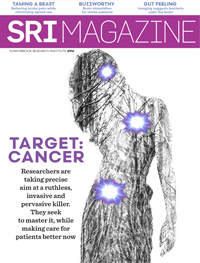How can we speed up biopsy for thyroid cancer?

Specialist backs doing it in the clinic using ultrasound
June 13, 2016

Dr. Kevin Higgins performs a thyroid biopsy under ultrasound guidance on a patient in the head and neck clinic at Sunnybrook.
Head and neck specialists at Sunnybrook’s Odette Cancer Centre are leading the way in endocrine surgery through use of point-of-care ultrasound and fine-needle aspiration, a minimally invasive procedure for evaluating disease in thyroid nodules.
The thyroid is an endocrine gland located at the base of the neck, in front of the throat. It has two lobes on either side of the windpipe connected by a narrow strip of tissue. The butterfly-shaped organ releases hormones that regulate metabolism, body weight, cholesterol levels and heart rate.
Dr. Kevin Higgins, a head and neck surgical oncologist at Sunnybrook, specializes in performing thyroid biopsies using 2-D ultrasound imaging that enables him to assess the lymph nodes and thyroid, and determine whether a patient needs a biopsy.
“Being able to do my own ultrasound not only allows me to speed up the process, but to be more accurate, efficient and capable at time of operation,” he says. “[It] allows us to identify the thyroid with structures at the root of the neck, into the thoracic outlet, and its relationships with the surrounding blood vessels, trachea and esophagus that we would not have appreciated from just reading a report. It gives a dynamic portal into the surgical anatomy in advance.”
During the 30-minute procedure, which is done during a patient’s first visit, Higgins moves the ultrasound transducer with one hand along the neck to locate the nodule on the thyroid. He places the needle on the thyroid, to aspirate with the other hand, a practice similar to drawing blood. Cells from the nodule are removed using a hollow needle and sent to a pathologist. Results are available in about a week.
Higgins recently co-authored the largest Canadian study to review the adequacy rate and learning curve for a single surgeon adopting ultrasound-guided fine-needle aspiration biopsy into practice. Adequacy in this case was defined as obtaining enough cells from the sample to allow a cytopathologist to interpret and provide a diagnosis.
Researchers looked at 423 biopsies of 289 patients who received the procedure at Sunnybrook between 2010 and 2015. They found an overall adequacy rate of 87%. There was a clear learning curve: adequacy improved each year, starting at 71% in 2010 and peaking at 94% in 2015. The learning curve was demonstrated by the proportion of patients each year who eventually received the procedure, regardless of the number of attempts.
“We showed that we are on par with, if not exceeding, what are considered acceptable norms for accuracy and adequacy of sample,” says Higgins. The study concluded that surgeons are capable of performing ultrasound-guided fine-needle aspiration of the thyroid. This is important, he says, as the procedure offers clear benefits. “Patients appreciate the convenience, and it ultimately allows for a dramatic wait times reduction,” he says, noting that a referral to a radiologist to do the imaging can take four to six weeks.
Carly McCready, a patient of Higgins’, says immediate testing lessened her anxiety. “I didn’t expect to have action taken so soon. I was pleasantly surprised the first day I met Dr. Higgins I had an ultrasound and biopsy. The next time I had an appointment, I had the information right away.”
Higgins’ research is supported by donations through the Head and Neck Initiative at the Sunnybrook Foundation.



